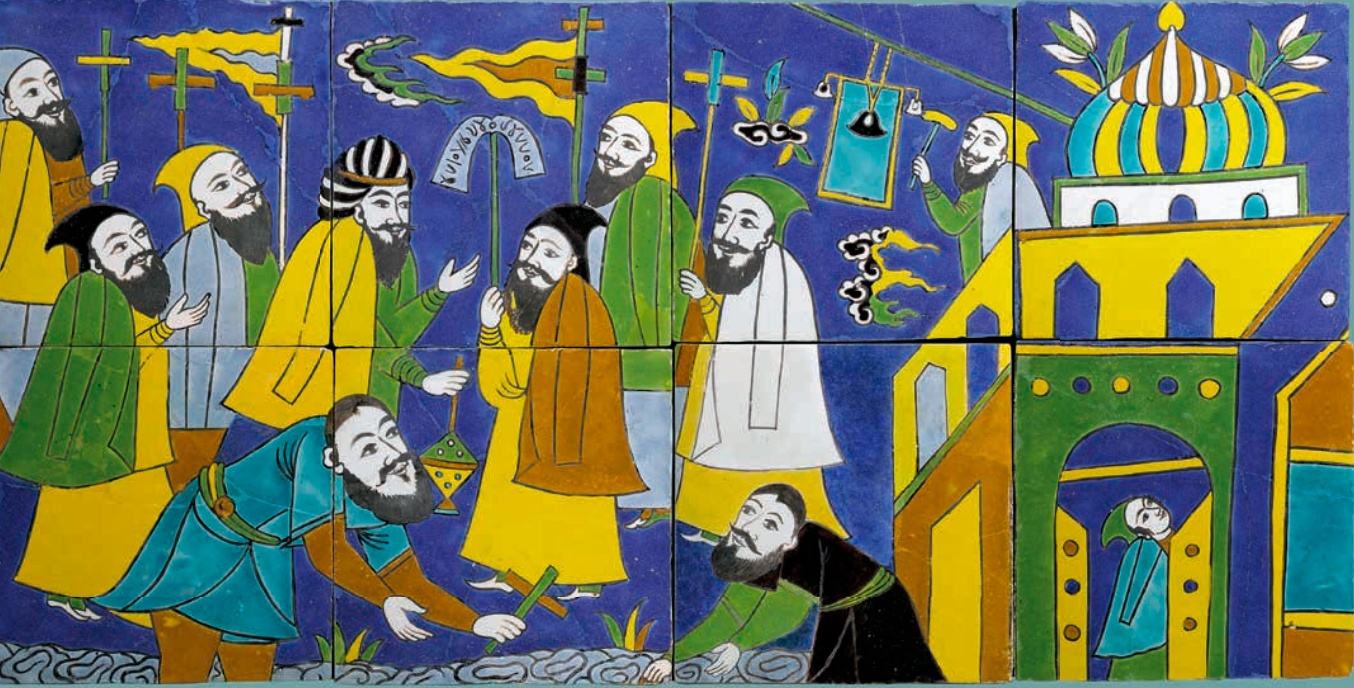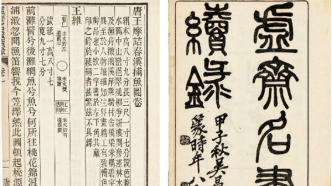
As a major plan for the 70th anniversary celebration of the Shanghai Museum, Shanghai Museum has rarely exhibited the 70-year-old Kesi of Zhu Kerou in the Southern Song Dynasty "The Picture of Duckling in the Lotus Pond" to the public (exhibition period: December 17-2023 January 1). In the 1950s, the Shanghai Municipal Cultural Relics Management Committee collected Pang Yuanji's ancient Chinese paintings and calligraphy from Xu Zhai's old collection through various forms. Cultural relics.
This article describes in detail the background of the time when "The Picture of Ducklings in Liantang" was collected in the Shanghai Museum, the whole process of its collection, and how the colleagues of the museum make reasonable and effective use of it under the premise of proper protection of cultural relics.
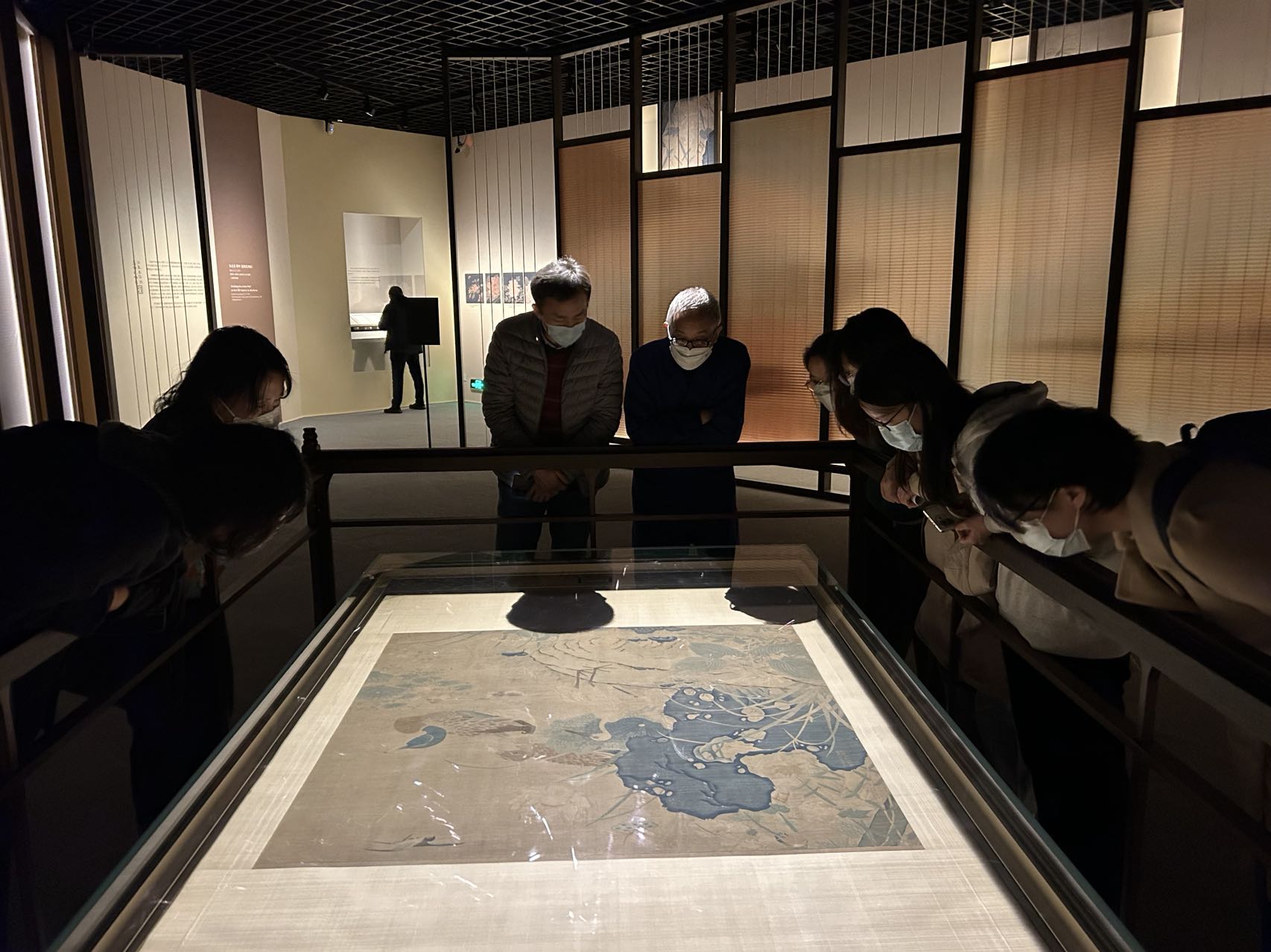
Shanghai Museum exhibition site
In the 1950s, the Shanghai Municipal Cultural Relics Management Committee collected Pang Yuanji’s fine ancient Chinese paintings and calligraphy from Xuzhai’s old collection through various forms. It is a cultural heritage of great value under the social background of turmoil since modern times, when a large number of cultural relics were outflowed and even damaged. It is a case of planning and practice of bringing history, art and science education into the national protection management and then providing the public with it. Zhu Kerou Kesi's "Liantang Duckling Picture" is the most representative cultural relic donated to the Shanghai Cultural Management Committee by the descendants of the Pang family. After the Shanghai Cultural Affairs Commission accepted the donation, "Liantang Duckling Picture" was handed over to the newly established Shanghai Museum for collection, protection, research and display. Due to the extreme fragility of textile cultural relics, focusing on how to meet the requirements of cultural relics protection and meet the needs of displaying to the public, colleagues in cultural relics museums have worked together to explore and innovate in the past 70 years, so as to excavate and interpret the value of cultural relics under the premise of proper protection of cultural relics. And make reasonable and effective use of it to enrich the historical and cultural nourishment of the whole society.

Southern Song Dynasty Zhu Kerou Kesi "Liantang Duckling Picture"
Since its preparation, establishment, and opening to the public, the Shanghai Museum has received the trust and care of cultural relic lovers and collectors, and has received strong support from social forces in collecting cultural relics and enriching the structure of its collections. Especially in the early days of the founding of the People's Republic of China, collectors of cultural relics turned their personal collections into public ownership through centralized transfers and voluntary donations, and actively participated in cultural construction. The Shanghai Museum has been able to become a museum with a collection of fine arts in a relatively short period of time, and has benefited a lot from this. Zhu Kerou Kesi's "Lantang Duckling Picture" is a precious cultural relic with important artistic value donated by Pang Weijin, Pang Zenghe and Pang Zengxiang when the Shanghai Expo was about to open in December 1952. Here, it is necessary to briefly explain the background of the times and the situation of Ponzi's old collection.
1. The Nanxun Merchant Gang and the Xuzhai Collection
From the Tongguang period of the Qing Dynasty to the beginning of the Republic of China, a regional business group with strong financial resources appeared in Nanxun, Huzhou, known as the "Nanxun Merchant Gang". elephant". Most of the Xun merchants started from the silk industry, and then got involved in many industries such as salt, banking, real estate, etc., and occupied a place in the evolution and transformation of the national bourgeoisie in modern China. With the expansion of business scale and scope, the Xunshang Group, which was active in Shanghai in the early 20th century, exerted a decisive influence on the politics, economy, culture and other fields of the southeast region. It is worth noting that many of the successors of the first generation of Xun merchants had a special interest in culture and art. Outstanding figures such as Pang Yuanji, Jiang Ruzao, Liu Chengqian, Zhang Naiji, and Zhang Heng emerged. , The cause of cultural relics had an important impact.

Pang Laichen
The prosperity of the Nanxun Pang family began with Pang Yunyu, and his achievements in culture began with Pang Yuanji. Pang Yuanji (1864-1949), courtesy name Laichen, nickname Xuzhai, was the second son of Pang Yunyu. Pang Yuanji was rich in money and was good at appreciating and collecting. He extensively dabbled in various cultural relics such as bronzes, porcelains, calligraphy and paintings, and jades. He especially collected ancient paintings extensively and well, "the best in the southeast" (Zheng Xiaoxu's words). Later, he compiled sixteen volumes of "Xu Zhai Minghua Lu" and four volumes of "Xu Lu" with the secret treasure "True and Essence". When Pang Yuanji was alive, his collection of ancient paintings gradually spread out, and the part that remained in China was collected in the Shanghai Museum in a relatively concentrated manner until the 1980s, following the fate of his heir Pang Weijin, grandchildren Pang Zengxiang, Pang Zenghe, etc. , the Palace Museum, the Nanjing Museum and the Suzhou Museum and other four public collection institutions. Collected by the Shanghai Cultural Relics Management Committee and the Shanghai Museum, and kept in Shanghai Bo’s old collection of Ponzi, the types include ancient calligraphy and painting including Kesi, porcelain, bronze, handicrafts and utensils, with ancient paintings accounting for the vast majority. The collection time was mainly in the 1950s.
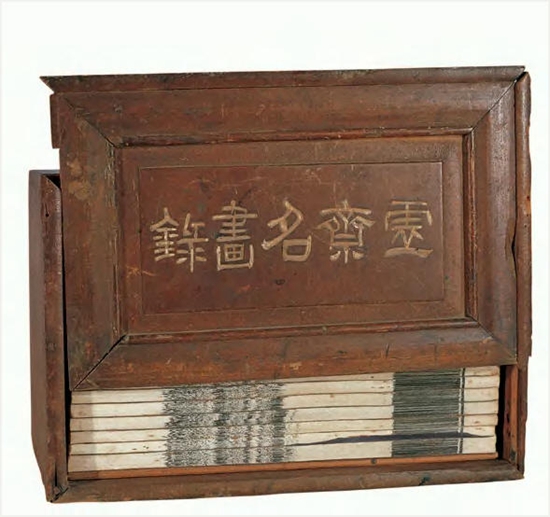
16 volumes of "Xu Zhai Famous Paintings"
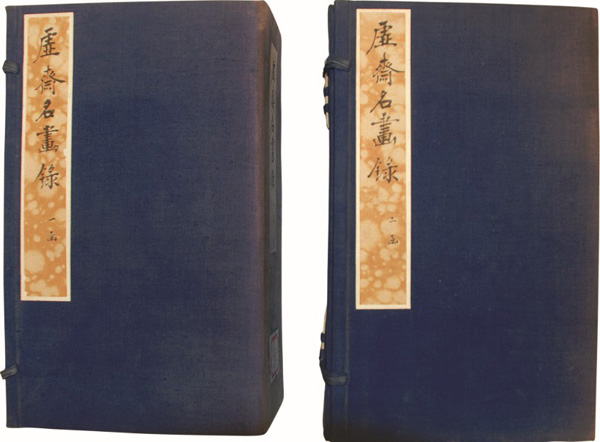
"Xuzhai Famous Paintings Record" letter

Title page of "Xu Zhai Famous Paintings"

Inside page of Xuzhai Famous Paintings Continued Record
2. The Shanghai Cultural Relics Management Committee collects the old collections of Xuzhai
In September 1949, the Shanghai Municipal Military Control Commission approved the establishment of the Shanghai Municipal Ancient Cultural Relics Management Committee, which was renamed the Shanghai Municipal Cultural Relics Management Committee in January of the following year. Receiving, purchasing, and accepting donations were the main methods used by the Shanghai Cultural Management Committee to collect cultural relics at that time. The cultural relics received are mainly delivered by various agencies, and the original sources are complex and diverse. The act of receiving is to implement the transfer of cultural relics ownership in accordance with the cultural relics management regulations promulgated by the people's government. The donated cultural relics mainly reflect the collection purpose of the collectors. Although part of the donation is affected by the mobilization of the staff of the Cultural Management Committee, the basic principle is to respect the personal wishes of collectors. The collection of cultural relics by means of acquisition, from a specific perspective, notably reflects the overall grasp of the preservation of cultural relics in Shanghai by the main participants of the Shanghai Municipal Cultural Relics Management Committee during this period, as well as the thinking and practice of building a cultural relics museum.
The objects of acquisition of cultural relics are mainly collectors' collections and cultural relics scattered in society. Modern Shanghai was the economic center of the country and also a collection and distribution center for cultural relics. On the one hand, the prosperity of the economy brings elegance and style, and many local capitalists and collectors in Shanghai have the strength to collect all kinds of antiquities in a wide range. In order to avoid the disaster of the war, many collectors from other places also immigrated to Shanghai, bringing with them family heirlooms of remarkable quantity and quality. Coupled with the large and small merchants swarming for profit in the cultural relics market, a huge amount of cultural relics gathered in Songbin. During the Taiping period, those who cannot be seen in secret pavilions often come to the world one after another, appearing one after another. On the other hand, a large number of cultural relics have changed hands among collectors and operators, or due to the pressure of the current situation, or the drive of profit, there are not many people who are outflowed or even unfortunately damaged. In such an era, the collection of funds is relatively limited, which cultural relics are the most important acquisition targets, and which cultural relics owners are the focus of the acquisition work, it really depends on the overall consideration and planning of the host staff.
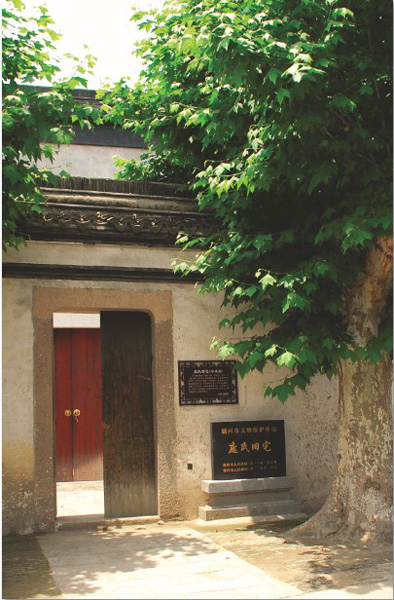
Pang Laichen Former Residence
Ponzi, who had moved to Shanghai, was undoubtedly one of the most eye-catching collections at that time because of his Xuzhai collection. The importance of the Ponzi collection can be seen from the words in the letter from Zhang Heng, who went to Beijing to serve as the deputy director of the cultural relics department of the Cultural Relics Bureau of the Central Ministry of Culture, to Xu Senyu, who is in charge of the cultural relics protection work in Shanghai and serves as the deputy chairman of the cultural management committee. "Pang's paintings, the Ming and Qing Dynasties can stand alone in the country. Fortunately, the elders pay attention to them, so as not to let them disperse." First of all, point out the old paintings of Pang Yuanji, especially the collections of the Ming and Qing Dynasties. This batch of collections is highly concerned and must not be lost. At the same time, it seems to imply that Beijing attaches great importance to Ponzi's old collection.
Xuzhai's collection of paintings and calligraphy is of high quantity and value, and the most concentrated sale was in 1952, which was jointly acquired by the Central Ministry of Culture and the Shanghai Cultural Management Committee, totaling more than 300 pieces. At the end of the same year, part of it was allocated to Shanghai in the form of allocation.
Earlier, in January and March 1951, the Shanghai Cultural Management Committee purchased part of Pang's old collection of calligraphy and painting from Pang Weijin twice. Although the Shanghai Museum had not yet been established at that time, the plan to establish a large-scale comprehensive art museum had been put on the agenda as early as 1950. The Cultural Management Committee was responsible for acquiring the three dealers of Pang’s calligraphy and painting——Xu Senyu, Xie Zhiliu, and Liu Ruli , were employed as members of the Preparatory Committee of the Shanghai Museum. It can be said that before the Shanghai Museum was officially opened to the public, the Ponzi collection, represented by the best ancient Chinese paintings, was acquired for the Shanghai Cultural Management Committee, and it was transferred from private collection for appreciation to the public. Once owned by the government's cultural relics policy enforcement agency, it is immediately endowed with public cultural and historical significance that faces the people, publicizes excellent artistic traditions, and promotes aesthetic education. This intention is implemented through the display and display of the Shanghai Museum.
3. Zhu Kerou Kesi's "Liantang Duckling Picture" was collected by the Shanghai Museum
In the process of collecting Pang’s old collections, the Shanghai Cultural Management Committee received the support and help of Pang’s relatives represented by Pang Weijin, the second generation successor of Xuzhai. In addition to completing three important acquisitions in 1951 and 1952, He and Pang Zengxiang donated cultural relics to the Culture Management Committee and the Shanghai Museum five times. The Southern Song Dynasty Zhu Kerou Kesi "Liantang Duckling Picture" donated in 1952 is the most precious one.
Pang Yuanji's Xuzhai Famous Paintings recorded a total of 545 hand scrolls, vertical scrolls, and album pages, each of which was marked as either silk or paper, or ink or ink. The only one included in the engraved silk version was Song Zhukerou's "Liantang Duckling Picture Axis". Based on this description, we can see that in Pang Yuanji's view, "The Picture of Ducklings in the Lotus Pond" belongs to the category of paintings. It is a special way of presenting the picture effect with silk threads. The money is complete, and it can be regarded as a forest of masterpieces by Juran, Guo Xi, Mi Fu and Li Di. It goes without saying that Pang Yuanji highly appraised the artistic value of this work.
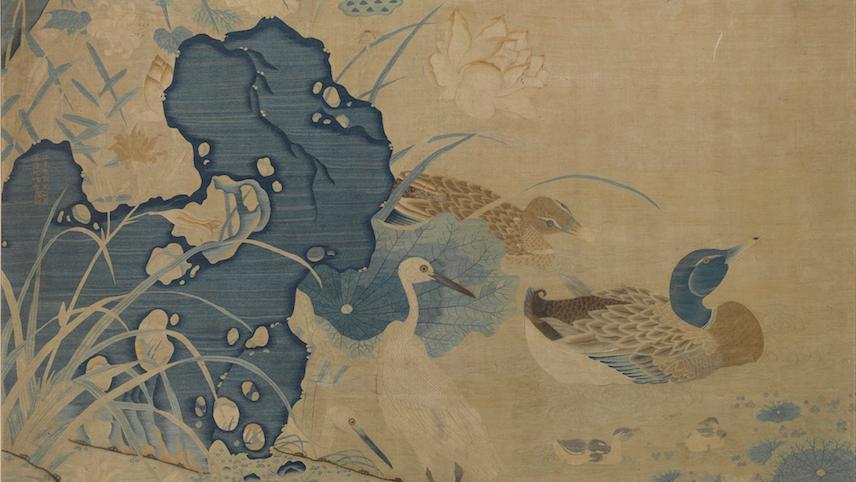
Zhu Kerou's Kesi "Duckling Duck in the Lotus Pond" (partial)
On December 5, 1952, Pang Weijin, Pang Zenghe, and Pang Zengxiang jointly sent a letter to the Shanghai Municipal Cultural Relics Management Committee, expressing their hope that the "Liantang Milk Duck Picture" and other 5 pieces of Ming and Qing Kesi "donated to the country and made public to the people" . In the donation letter, Pang Weijin and others gave special recognition to Kesi as a special ancient Chinese art form:
I would like to find out that the art of silk carving in my country dates back to the Zhou and Han Dynasties, flourished in Tang Zhenguan and Kaiyuan, and reached Zhao, Song, Hui and Gao Dynasties. However, due to the complexity of its engraving, it may take many years to complete a single painting, and I am afraid that it will not be able to complete the work, and it will become even more rare when its fine works are handed down. ... This kind of handicraft art unique to our country is the most representative of the tradition of our national art and the wisdom of our nation.

The scene of the exhibition hall, the donation book of the Ponzi family
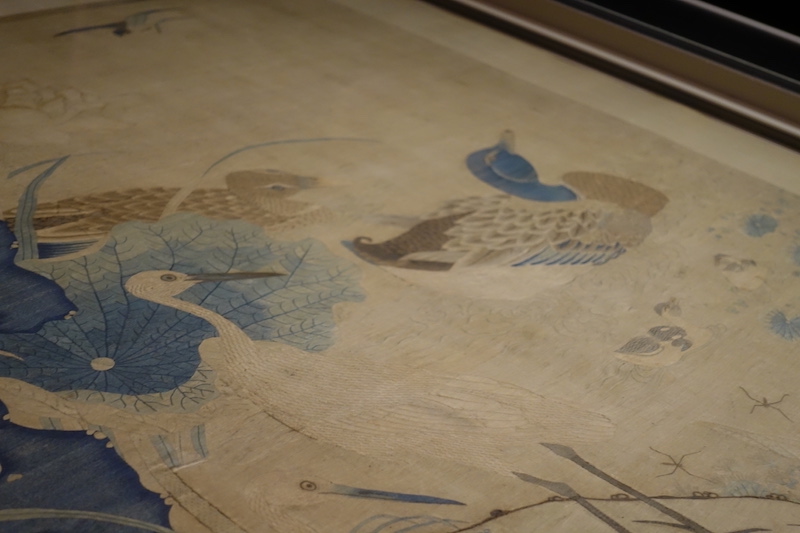
Zhu Kerou's Kesi "Duckling Duck in the Lotus Pond" (partial)
As far as Zhu Kerou's Kesi "Lantang Duckling Picture" is concerned, "the coloring and arrangement are absolutely wonderful" , and it is a "treasure" . "To be shared by the people, it will make the unique art of our nation flourish and shine through the ages." The Shanghai Cultural Management Committee highly appreciated and praised it, and then displayed it in the Shanghai Museum and made it public. Among them, those made by Zhu Kerou in Yunjian (now Songjiang, Jiangsu) are the most famous", "they still followed the tradition of the Song Dynasty in the Yuan and Ming Dynasties."
On the other hand, textile cultural relics have strict requirements on storage and exhibition conditions. Light, temperature, humidity, etc. are all factors that affect the aging of textiles, while microorganisms, pests, and air pollutants will directly cause damage to textiles. Equipment and materials are also closely related to the preservation status of cultural relics. A request for instructions drafted by Cheng Mingshi and Xu Xiaomu, who were in charge of cultural relics preservation at the Shanghai Museum in October 1955, reflected the problems and challenges faced in the display and storage of the "Suckling Duck in the Lotus Pond".
According to Cheng and Xu, "The Kesi silk of Song Dynasty Zhu Kerou in our museum was originally in the hanging scroll style, but it was temporarily refitted into the mirror heart style because of the need for display." The "originally hanging scroll" mentioned here is consistent with the "picture axis" in "Xuzhai Minghualu", which shows that it was displayed and stored in the form of a scroll when it was in the Pang family. However, shortly after it was donated to the Shanghai Cultural Management Committee and collected in the Shanghai Museum, "The Picture of Ducklings in Liantang" was changed to a mounted exhibition storage, that is, it was changed to a "mirror-heart painting". Stretching and curling operations avoid friction and reduce damage to silk cultural relics. However, after a period of display, the state of preservation of cultural relics has declined, and "a slight unevenness was found in the format". After analysis, it is believed that the main reason for this phenomenon is that "the original framed back is too thin" and "the display time is long".
Judging from the situation at the time of "Liantang Duckling Picture", the unevenness of the format was mainly caused by the difference in shrinkage between the mounting paper and the silk tapestry when the temperature and humidity in the display environment changed slightly. The back covering is too thin, that is, in the case of a difference in shrinkage between the backing and the textile, and because of insufficient rigidity, the fabric cannot be kept stretched and crisp. And "longer display time" means that if no adjustment is made, the fatigue limit of the fabric will be exceeded, and the original recoverable deformation may evolve into irreversible permanent damage.
Furthermore, longer periods of light may increase the surface and internal temperature of Kesi silk, resulting in changes in internal stress and warping. In addition, changes in air temperature and humidity in the showroom will lead to changes in the moisture content inside the Kesi silk, and the penetration or precipitation of water molecules will also cause appearance changes such as wrinkling, deformation, and warping. The longer the display time, the more obvious the accumulation of adverse effects. In addition, the increase in air temperature and humidity will also promote the reproduction of mold, insect pests and microorganisms, which will pose a threat to Kesi.
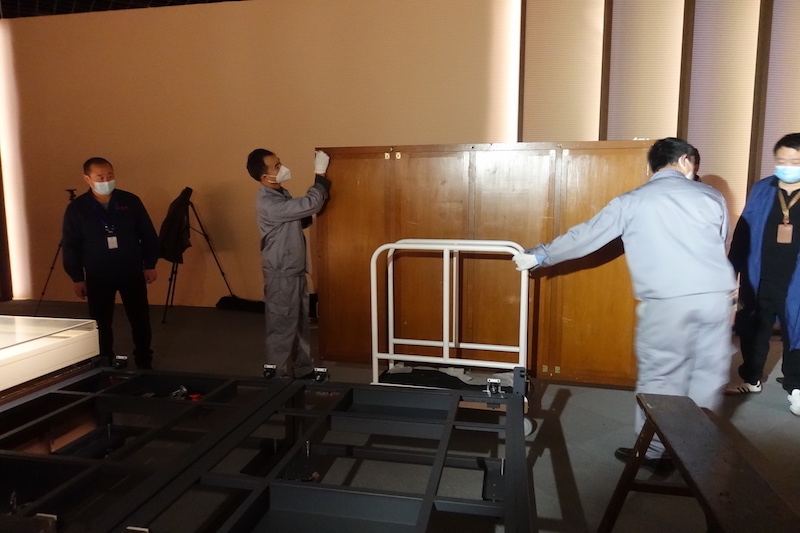
Exhibition site Wooden boxes built in the 1950s and 1960s
On the basis of careful observation of "Liantang Milk Duck Picture", careful analysis of the causes of the problem, and extensive consultation with the opinions of the industry, the preservation department of Shanghai Bo has drawn up a restoration plan for cultural relics. The shape of the heart makes the tapestry silk flat and compliant, and the lining board has good support. On the other hand, wooden storage equipment is customized for cultural relics to ensure that the "Liantang Milk Duck Picture" is always kept flat, so that the fabric fibers can be relaxed to the greatest extent. Yang Kuan, the deputy director of Shanghai Expo at the time, approved the re-mounting plan, and seriously emphasized that "Liu Dingzhi must be carefully preserved when mounting, so as to ensure that the original objects are not damaged. If Liu Dingzhi thinks that he is not sure, he will reconsider." Demonstrated an extremely prudent attitude and the working principle of taking the safety of cultural relics as the first premise.
According to the actual situation of cultural relics, it is an important principle for the preservation, research and display of cultural relics of the Shanghai Museum to formulate and adjust the protection and display plan in a timely, scientific and accurate manner. Afterwards, in the "Exhibition of Silk Weaving, Embroidery, Printing and Dyeing Crafts" in 1958, "Duckling in the Lotus Pond" was displayed in a table and cabinet. In 1993, the "Shanghai Museum Famous Products Exhibition" in Tokyo, Nagoya, and Fukuoka, Japan, was inlaid in the mirror frame and displayed on a slanting board. Up to now, thanks to the careful protection of museum colleagues and the progress of hardware equipment and technical means, "Liantang Duckling Picture" has maintained a good and stable state.
In recent years, as a practical exploration and important innovation achievement of the integration of textile protection, storage, display and display, the Craft Research Department, Cultural Relics Protection Science and Technology Center, Storage Department, and Display Design Department of the Shanghai Museum worked together to customize the following for a batch of Kesi cultural relics in the collection. The acid-free cotton cardboard and acid-free corrugated cardboard are used as the inner lining, and the external aluminum alloy frame and anti-bending low-reflection glass lens are installed to realize the uniform form of cultural relics during exhibition and storage, avoiding the need for storage, transportation, and exhibition. Possible injury caused by unnecessary handling. Among them, the Ming Dynasty Kesi "Buddha's Hand Flower and Bird Picture" donated in the same batch as the "Liantang Duckling Picture" and the Qing Dynasty Kesi "Flower and Bird Picture", as well as the Ming Dynasty Kesi "Picture of Immortals Gongshou" are extremely large in size, covering two Three square meters, after this modification, the two aspects of cultural relics protection and observation effect have been particularly prominently improved. In 2021, "Silk Lianqing-Special Exhibition of Ming and Qing Embroidery Calligraphy and Painting" and "Alpine Scenery-Exhibition of Cultural Relics Donated by Shanghai Museum" brought excellent viewing experience.
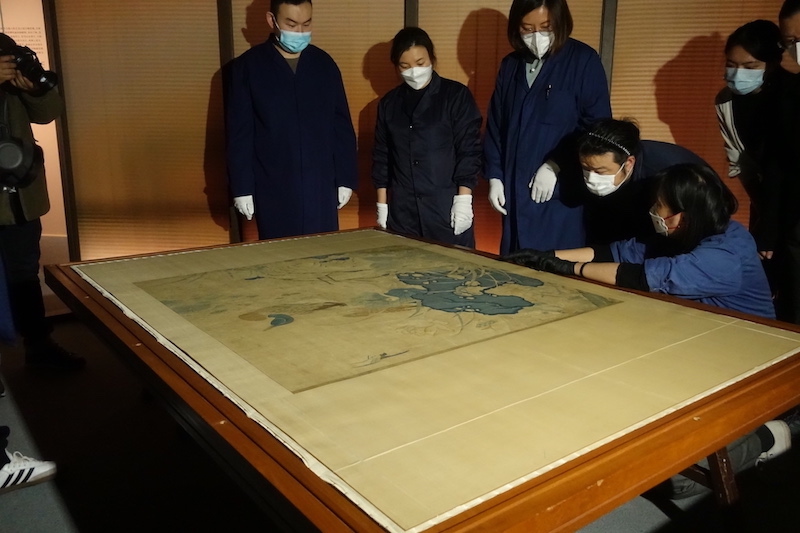
The staff at the exhibition site took out the tapestry

The staff at the exhibition site placed Kesi in a special showcase
This time, "Auspicious Concentration: Suckling Duck in the Lotus Pond of Kesi in the Secret Collection of Shanghai Museum" strictly follows the requirements for the storage and display of Kesi cultural relics, in order to provide the public with high-quality viewing conditions as much as possible, combining future preservation, For the medium and long-term needs of display and research, after multi-party research and cooperation, a special exhibition and storage plan was customized for "The Picture of Milk Duck in Liantang". One is to make special preservation cabinets according to the size of cultural relics in the warehouse stage, which not only ensures that there is no need to directly contact cultural relics when extracting and storing them, but also allows people to observe cultural relics without opening the preservation cabinets. Second, in the stage of the exhibition hall, "Duckling Duck in the Lotus Pond" was placed on display in an independent table and cabinet in the central area of the exhibition hall. The size and structure of the display cabinets match those of the storage cabinets in the warehouse, and the cultural relics can be "seamlessly switched" into the display cabinets through overall movement and loading. This process does not require touching the Kesi itself. At the same time, through a series of work such as optimizing the materials of the showcase, carefully calculating the variables such as illuminance, exposure, temperature and humidity, and carefully debugging the equipment, the depth of the showcase was successfully shortened. The installation of equipment such as lighting and environmental monitoring and adjustment has also been carefully considered and cleverly arranged. On the basis of proper protection of cultural relics, the audience is able to appreciate the Kesi treasure "Suckling Duck in Liantang" in a "detailed and detailed" way.
The Shanghai Museum has always attached great importance to the research of cultural relics and actively promoted the research results to the academic circle. The steady advancement of research has deepened the overall understanding of cultural relics, which is not only the guidance and basis for formulating long-term protection plans, but also the basis for holding exhibitions, providing historical and cultural education to the public, and guiding aesthetic appreciation. For example, the two special exhibitions of "Sili Danqing" and "Ruise Ningguang" display the cultural relics at the same time, in various forms such as loom models, technical illustrations, animation simulations, exhibition catalogs, etc., the artistic characteristics of traditional Chinese weaving, The craft techniques are vividly and clearly introduced to the audience, so as to realize the knowledge sharing about the aesthetic value and production technology of traditional embroidery art.
Zhu Kerou Kesi's Painting of Ducklings in Lotus Pond is a representative of Pang Yuanji's collection of ancient art treasures, and Pang's old collection is another case of Shanghai Museum's collection of cultural relics. An ancient relic with important artistic value has changed from one-person appreciation to sharing with the public the splendid achievements of the ancestors in the exploration of the material and spiritual world. During this period, the good expectations of cultural relic collectors are condensed, which is also the practice of cultural relic museum workers. A silhouette of a tireless effort to fulfill a mission.
4. Reverberation
A few days after donating Kesi treasures such as "Liantang Milk Duck Picture", Pang Weijin, Pang Zenghe, and Pang Zengxiang wrote to the Shanghai Cultural Management Committee, writing in the letter, "Most of the old paintings in my family have been purchased by Junhui. Dedicate the two painting cabinets to the Junhui, and use them as scrolls." These two painting cabinets should be the equipment used by the Pang family to store calligraphy and painting scrolls in the past. The two generations of Xuzhai's heirs solemnly presented them to each other, not because the cabinets are expensive, but because they embody the deep affection of the collectors. One is pairing old objects with ancient objects, which restores the old appearance of Ponzi’s collection in a sense, which is a comfort to former collectors. The symbol of "Yongbao Yong" is the earnest entrustment of collectors to public collection institutions. This is not only a direct support for the cause of cultural relics museums, but also a spur to cultural institutions.
Since the establishment and opening of the Shanghai Museum, how to properly protect the cultural relics in the collection, how to deepen and expand the research on cultural relics, and how to vividly display and interpret cultural relics to the public have always been the direction and goal of museum people to explore and practice. Seventy years of Spring and Autumn, I have been busy all day long, and I am vigilant at night, not daring to ignore it for a moment.
When talking about his collection, Pang Yuanji once said, "People in the blue sky do not want their fame to be obliterated, so I specially ordered Yu Po to collect them and spread them widely?" In the donation letter, Mr. Wang also said that donating cultural relics and treasures to the country is "shared by the people", and "it has a deeper meaning than a family's private property, and it is not the same as Japanese." The former is about the responsibility of inheriting, protecting, and passing on the excellent historical and cultural heritage, while the latter emphasizes the importance of excavating and interpreting the value of cultural relics, enriching the historical and cultural nourishment of the people, and giving full play to the social functions of cultural relics. The responsibilities and tasks of the museum are almost here.
(The original title of this article is "Who will pass on the lamp to Song Xian - the protection and utilization of Xuzhai's old collections such as "Liantang Duckling Picture"". This article was written by Shen Yuyang, who is in charge of document and archive management at the Shanghai Museum Office. Yu Ying from the Department, Zhao Cenzhen and Xi Zhe from the Custody Department, Han Xiaoying from the Cultural Relics Protection Technology Center, Jin Keyu and Lin Wensi from the Exhibition Department, Zhang Jie from the Cultural Exchange Office, and the Display Design Department for their help, I would like to express my gratitude here. )
